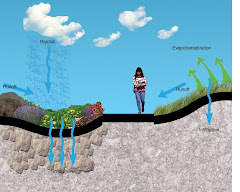Up to 70 percent of harmful pollutants are introduced by storm water runoff: unfiltered water that reaches waterways by flowing across impervious surfaces: roads, parking lots, driveways, and roofs. Runoff deposits pollutants – via storm drains and sewers into our lakes and streams. Lawn clippings and leaves are also washed into our waterways, reducing oxygen levels and ultimately suffocating fish and other aquatic species. Water that comes off an asphalt roof onto an oil-stained driveway will flow across an over-fertilized lawn straight into creeks, rivers, and lakes.Rain gardens do the opposite. By integrating stormwater into building and site development, raingardens can avoid or mitigate the damaging effects of urbanization to rivers and streams, preventing Global Warming. By keeping stormwater close to where it falls, rain gardens reduce flooding and settle out sediments. They not only prevent stormwater from becoming contaminated, they actually remove pollutants from the water as it percolates through the soil on its way to becoming groundwater.
Saturday, October 20, 2007
A Sustainable Approach
Subscribe to:
Post Comments (Atom)


No comments:
Post a Comment